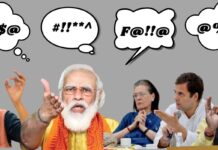[vc_row][vc_column][vc_column_text]
The more we invoke Gandhi, the more we are sure about his charisma. The Father of the Nation has his relevance intact to this date and time. Hence, any reference of him conveys the message louder and will have a greater impact if timed right and with a clear purpose.
In this context, Chief Justice Ramana rightly invoked the legacy of the mahatma and his associate during the freedom movement, Bal Gangadhar Tilak, to bring home the point that certain British era laws are proving an infringement of civil liberties. He pointed out that such archaic laws had put the Indian democracy of the country in jeopardy.
“It is time to hold sedition law to the litmus test of freedom of speech,” observed the Chief Justice in response to a petition challenging Section 124A of the Indian Penal Code (IPC).
The message is loud and clear, the sedition law must go. Coming as it does straight from the highest judiciary of the land it’s a reprimand for all the institutions of the democracy, including the legislature, the law enforcing agencies of the state, and even the judiciary for keeping the shame of the colonial regime alive after 70 years of independence. It’s a matter of shame that the world’s largest democracy is still carrying the burden of a 150-year-old law which was meant to suppress the free voice of its citizens under the tyrannical colonial rule.
This is the third time in a little over a month that the apex court had to ask the government to re-examine the remit of sedition law. The case against Section 124 A of IPC known as sedition law keeps coming up again and again because of its archaic structure, low conviction rate, long proceedings, and intentions behind the prosecution. A total of 326 cases were registered in the country under the controversial colonial-era penal law on sedition between 2014 and 2019 in which just six persons were convicted.
Coming close on the heels of the death of the sedition accused, Father Stan Swamy, inside prison, the Chief Justice’s invocation of Gandhi and Tilak seems to have hit home this time around. Charged with sedition under the stringent Unlawful Activities Prevention Act (UAPA), the 84-year-old incarcerated social activist died on July 5 waiting for bail in the sedition case.
During his incarceration, the ailing Swamy pleaded with the court for his bail on health grounds several times. The death of the octogenarian prisoner has put a question mark on the increasing culture of weaponising of certain laws to stifle free speech, outlaw protests, and thereby muzzle dissent in democratic India.
The reference of the arrest of Gandhi and Tilak juxtaposes the historical cases against the latest incarceration of human rights activists, academicians, and intellectuals booked on trumped-up charges under the same British-era legislation. The law enshrined in Section 124 A of IPC was introduced by the British government in 1870 to tackle dissent against colonial rule. Gandhi was arrested in 1922 on charges of sedition in Bombay for taking part in a protest while Tilak was arrested in 1897 for writing an article in his weekly ‘Kesari’ against the British rule.
Many of those charged with sedition, including writer Arundhati Roy, pediatric Dr Binayak Sen, politician Kanahia Kumar, student activists Disha Ravi and even a 14-year old Bangalore girl who was arrested in 2020 for raising the “Pakistan Zindabad” slogan followed by “Hindustan zindabad”, are all citizens of this constitutional democracy guaranteed constitutional safeguards under Fundamental Rights including free speech and expression.
This unambiguous stand of the apex court makes a strong case against the sedition law which has of late had a “chilling effect” on democracy putting unreasonable restrictions on the fundamental rights of the citizens including free speech enshrined in Article 19 (1) (a) of the Constitution.
Although sedition remained a rare crime in comparison to other offenses, accounting for less than 0.01% of all IPC crimes, the increasing use of the law in recent years against protesting students, activists, and farmers calls for its review. In fact, the law has become a weapon in the hands of the state machinery to be used against political opponents or whoever raises voice or dissent against the government.
In January 2020, more than 3,000 anti-Citizenship Amendment Act (CAA) protesters, and in 2019, more than 3,300 farmers protesting over land disputes were charged with sedition. The CJI’s concern that “if the police want to fix somebody, they can invoke section 124A” covers those who are using their fundamental right to free speech and expression by protesting against policies of the government but are eventually charged with the stringent sedition law.
Although constitutional validity of the sedition law was upheld by the Supreme Court in 1962 in a landmark Kedar Nath Singh case, there was an attempt to restrict its scope. The court held that unless accompanied by incitement or call for violence, criticism of the government cannot be labeled sedition.
The court has been repeatedly reminding the government to remit the sedition law. But it failed to re-examine whether this 59-year-old Kedar Nath Singh judgment holds in the present context. In 2016, the government itself had admitted to Parliament that the definition of sedition is too wide and requires review.
The Law Commission also released a consultation paper in 2018 that said, “In a democracy, singing from the same songbook is not a benchmark of patriotism. People should be at their liberty to show their affection towards their country in their own way”.
Moreover, when it comes to defining free speech and expression, no other law, least of all the one having an archaic foundation, can supersede a law that derives from the fundamental rights. Such a law needs to be overpowered and demolished. The vague definition of sedition in vogue today that renders both provocative and innocuous speeches and writings equally liable for prosecution needs to be re-examined.
The fundamental rights uphold the civil liberties and basic human rights and the Indian constitution, in the words of Justice D Y Chandrachud, it is the North Star against which conformity of every state action or inaction would have to be judged. Even a semblance of a clampdown on civil liberties is upsetting the sacred promise made to our ancestors who accepted India as their constitutional republic.
The Kedar Nath Singh judgment has specified the provision of the use of sedition clearly. What’s intriguing about the law which is a colonial legacy is that the motive behind it is colonial.
Since “dissent is the safety valve of democracy”, it is important to safeguard the right to dissent and disagree. Unfortunately, the threat of the sedition law overshadows the key democratic right of the citizens. What’s more, the law has been misinterpreted in many cases has been proved time and again by the low conviction rate.
[/vc_column_text][/vc_column][/vc_row]
Disclaimer: We do undertake rigorous checks on content provided by contributors before publishing the same. If you come across some factual errors, kindly bring this into our notice and we shall review your objection and claim as per our policy and display correction credits and corrections on the article itself.
The opinion expressed in the article is of the writer. Writer is a freelance journalist/journalist based in Delhi





























